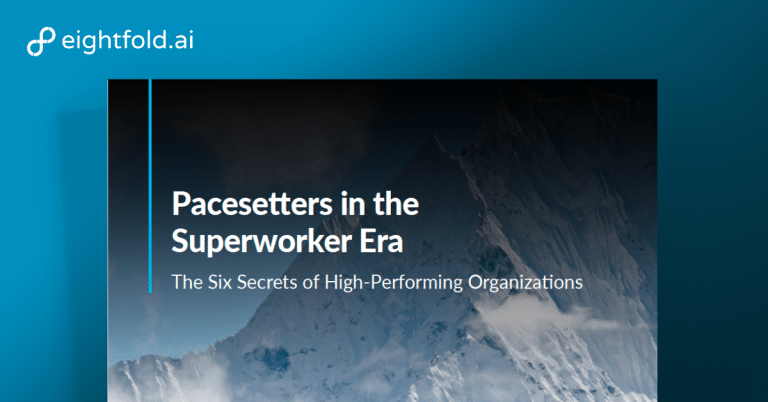
Pacesetters in the superworker era: The six secrets of high-performing organizations
Pacesetters in the superworker era: The six secrets of high-performing organizations
In an era of rapid AI advancement, a select group of companies is pulling ahead of the pack. These “pacesetters,” making up 5% to 10% of every industry, are not just navigating the disruption but are actively accelerating their lead by leveraging AI and human talent in innovative ways.
In this report, The Josh Bersin Company delves into the distinct strategies these forward-thinking organizations employ. The research explores how these “pacesetters” are using data and technology to address industry-specific challenges, ensuring they not only outperform their peers today but also widen their competitive gap for the future. By examining sectors from automotive to healthcare, the report outlines the practical and strategic approaches these high-performing companies use to thrive.
Read the full report to learn:
- Why pacesetters leverage AI for growth and innovation, not just cost control, to unlock new revenue streams and unleash human potential across the enterprise.
- Why investing in internal mobility and dynamic skilling is a more effective long-term strategy than defaulting to external hiring to fill critical talent and capability gaps.
- How to shift from rigid change management to a culture of “change agility,” creating a resilient workforce that embraces and leads through continuous transformation.
In every industry, 5% to 10% of companies emerge as clear frontrunners—strengthening their position and accelerating their lead with every strategic move. We call these companies “pacesetters.” Indeed, as we see in our Global Workforce Intelligence (GWI) Project, pacesetters take a distinct approach to problem-solving and prioritize different skills and roles in their organizations.
With AI disrupting every industry and challenging business models and operating approaches, the potential to learn from pacesetters is immense. Advancing at unprecedented speed, AI impacts not just one area of the organization but every part, simultaneously and with greater force than ever before.
What strategies do pacesetters leverage to create “superworker” organizations? What skills and roles do they prioritize? How do they continuously adjust and stay on top of changing technological capabilities? Where do they focus their energy, not just to lead today but to increase their competitive advantage using a combination of AI and people?
This report delves into the six strategies that set pacesetters apart, offering insights into their success in the age of the superworker.
Meet the pacesetters: Winning the AI game
AI disruption is reshaping every company, business model, product, service, job, and skill. We’ve moved beyond isolated AI use cases and entered a new age of business transformation powered by AI agents. We’re now heading into a world where humans support AI to perform entire tasks autonomously, ushering in the age of the superworker.
According to the 2025 PwC CEO survey, 92% of CEOs are heavily investing in generative AI—not only to reduce costs but also to drive meaningful, sustained revenue growth. Yet, only 23% believe their organizations can truly adapt, and just 7% are successfully generating new revenue sources.
Meanwhile, industry lines are blurring: 40% of CEOs believe their sector now overlaps with others—a trend we’ve long called “industry convergence”.
Who are the pacesetters?
Launched in 2022, our GWI Project aims to uncover key business issues industry by industry, identify strategic HR and talent solutions to address them, and understand what sets the most successful organizations apart. These pacesetters don’t just outperform their peers—they continue to widen the gap. Their success goes well beyond financial performance.
Industry leadership: Solving problems with data and technology
To date, we have completed studies in six different industries—each facing unique challenges that pacesetters address with a systematic and strategic approach, serving as models for others and offering a benchmark for comparison.
While these approaches vary to meet each industry’s unique challenges, our deep analysis and comparison of skills, roles, and organizational strategies reveals consistent patterns among pacesetters. Organizations seeking to empower superworkers—employees who leverage AI and advanced technology to significantly elevate their performance, productivity, and impact—can adapt these approaches to guide their own AI transformation journeys.
By examining the nuanced roles and skills pacesetters prioritize, the strategies they use to solve business problems, and real-world examples, we identified three practical approaches HR and business leaders can adopt to succeed in AI transformation—and ultimately build superworker organizations.
You might also like...
Get the latest talent news in your inbox every month
By submitting this form, I consent to Eightfold processing my personal data in accordance with its Privacy Notice and agree to receive marketing emails from Eightfold about its products and events. I acknowledge that I can unsubscribe or update my preferences at any time.
